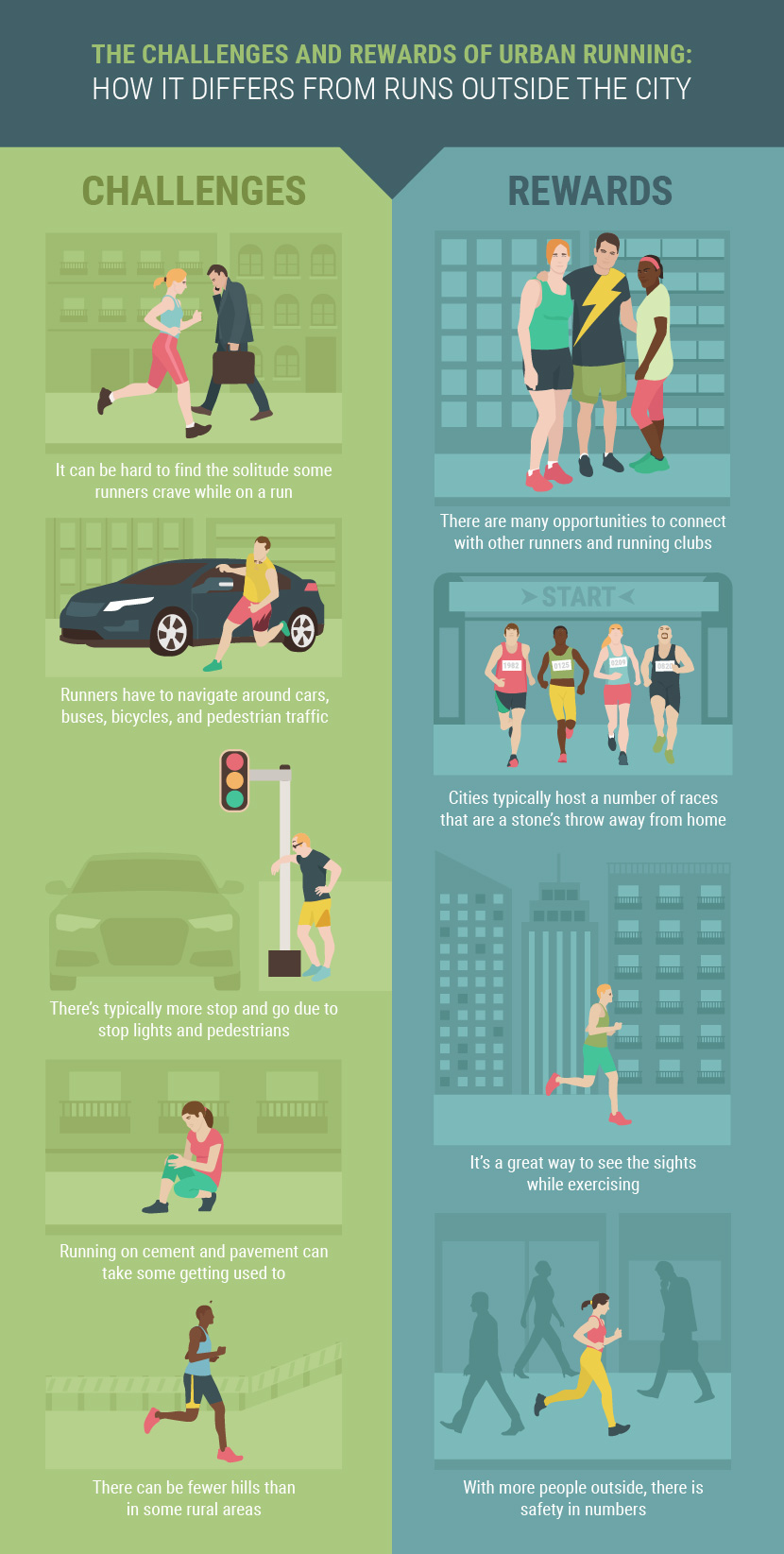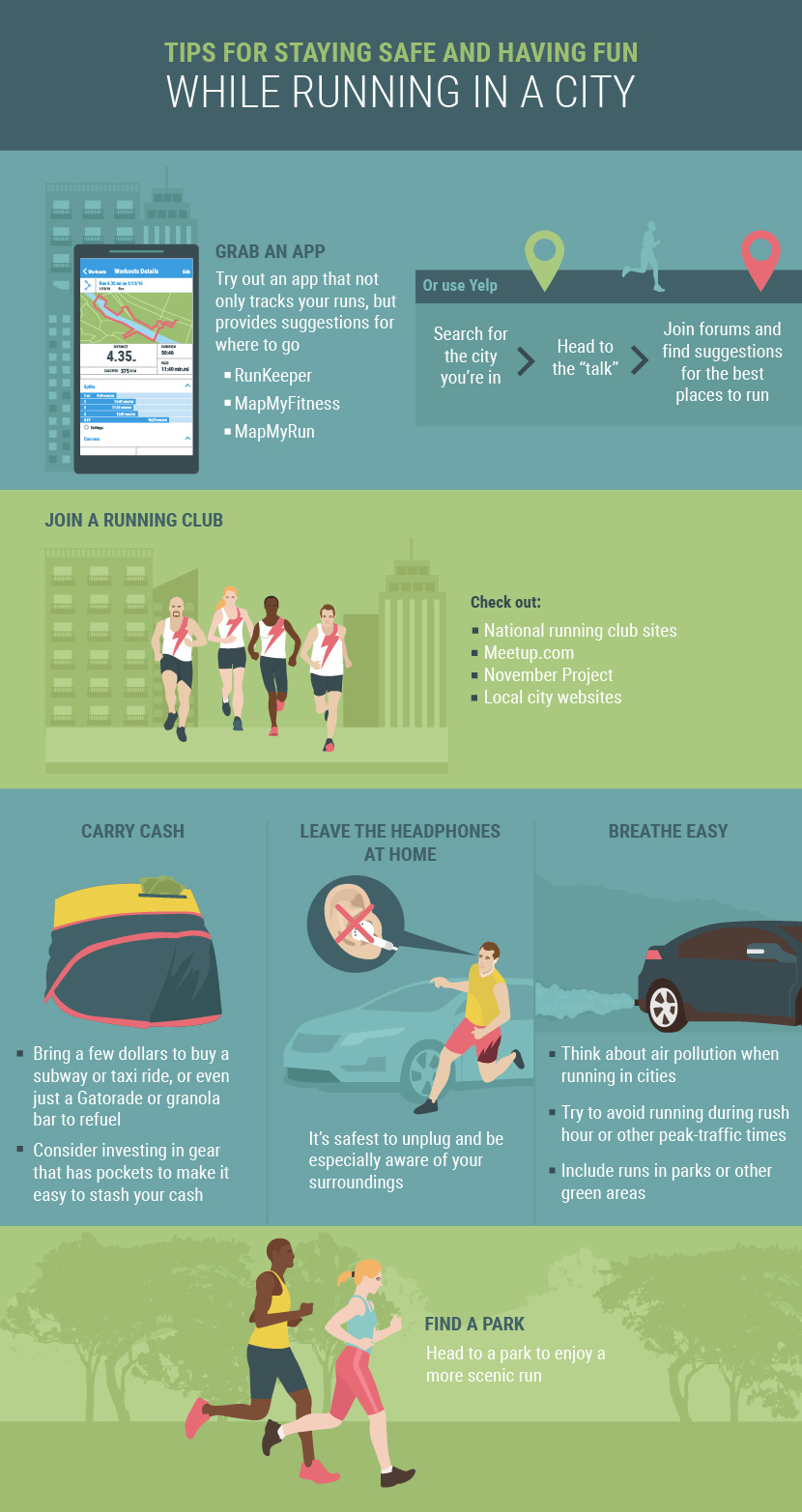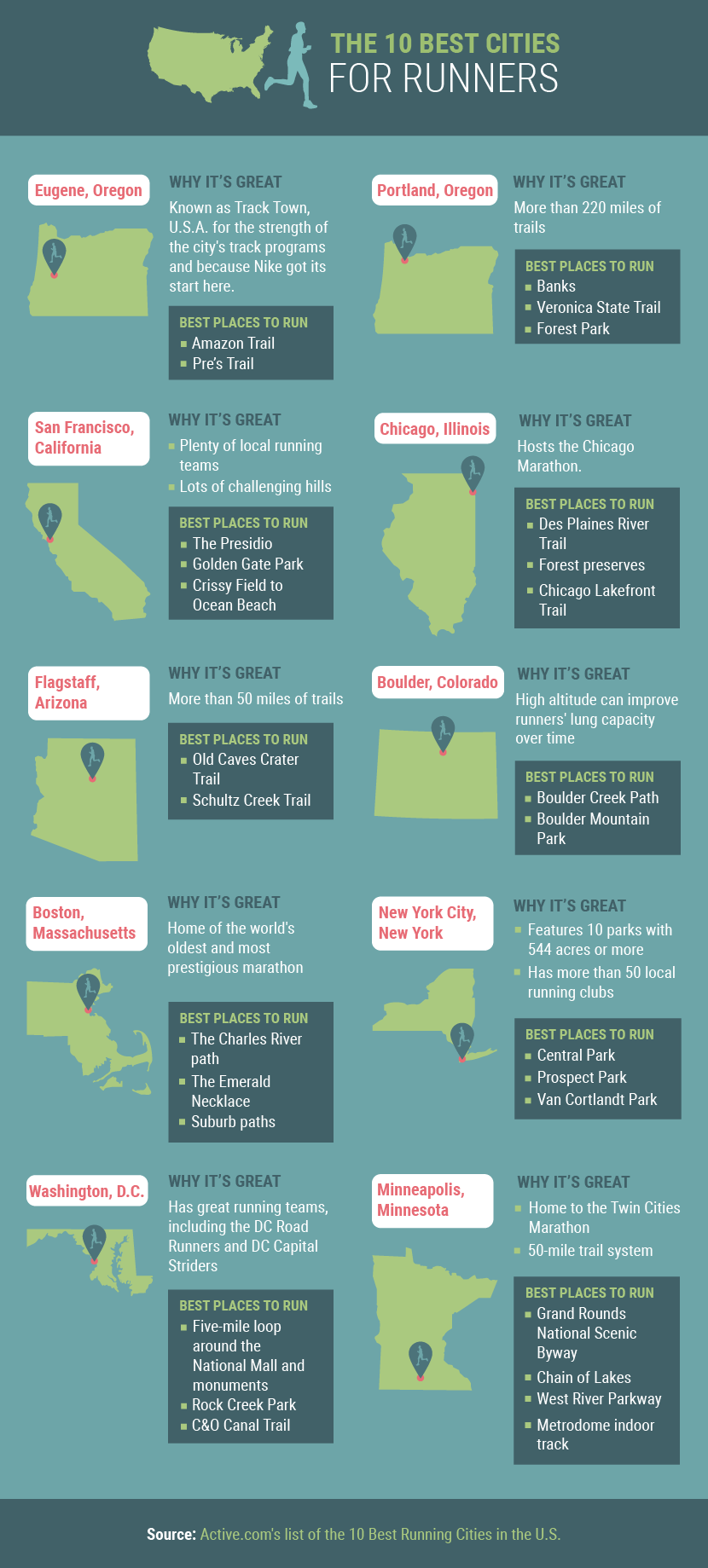Urban Legend: The Challenges and Rewards of Urban Running
Photos of nature-filled runs abound on Pinterest, from a runner blazing through a beautiful trail with mountain peaks in the distance to a group of joggers traveling into the sunset alongside the shoreline.
But what about the city runner who weaves through urban trails next to towering buildings, a blur of taxi cabs, and a sea of other pedestrians? While it may not seem as easy or as serene to run in cities, there are definitely ways to do it right and explore new neighborhoods while you’re at it.
Hitting the city streets is unlike running on any treadmill or trail you’ve ever experienced, so we’ve provided tips to run in any metropolis and a list of the best cities to explore by running.
Hit the (City) Trail Running: How Urban Running is Different

Running in the city may not be as hard as you think. One “urban legend” is that continuously pounding on pavement can be a literal pain in the butt. If you’re in the city, you will most likely run on cement. Luckily, a good deal of research suggests that the body can adjust to the surface it repeatedly runs on, meaning that all that pounding is the same, whether it’s on a hard or a soft surface. http://www.ncbi.nlm.nih.gov/pmc/articles/PMC2786815/ (If you’re feeling achy, your running form may be to blame. )
However, some things are especially unique to urban running. For one, there’s traffic. You encounter more stop-and-go when running in the city, so it’s best to seek out running paths designated for pedestrians to avoid having to stop every few blocks. If you do have to stop, you can take advantage of the break and do some squats and lunges.
You also have to get more creative to find diverse running routes. Many cities have fewer hills (unless you live in San Francisco), and unlike the treadmill, you can’t just magically hit a button to increase or decrease the incline. Plan accordingly to find a run that works for you. Many runners take public transportation to find tracks, hills, or parks to experience a change of scenery while avoiding crowds and cars.
Cities are also known for the hustle and bustle of people, so you probably won’t ever be alone on a jog. If you’re looking for solitude on a run, it’s best to go early in the morning – but make sure to wear reflective gear if it’s still dark out.
Running in the Urban Jungle

Here are some additional tips for city runners to stay safe and have fun:
Grab an app
Sometimes the trickiest part of running in the city is knowing where to go. Luckily, a lot of great fitness apps not only track your runs but also provide suggestions for where to go. Some of our favorites include RunKeeper, MapMyFitness, and MapMyRun. If you’d rather leave the apps behind, Yelp can help. Search for the city you’re in, head to the “talk” tab, and then join forums and find suggestions for the best places to hit the streets.
Join a running club
It is easier than ever to find a running club near you. A running crew movement has taken cities by storm, and these suit any type of runner, from couch-to-5Kers to ultra marathoners. http://dailyburn.com/life/fitness/how-to-prevent-running-injuries/
One group that has gained a ton of momentum is the November Project, a free fitness movement with roots in Boston that has spread across the country. When you join, they’ll have you sprinting, planking, and lunging around your city all before heading to the office for work. How’s that for a morning routine?
Leave the headphones at home
While listening to a little Beyoncé or Jay-Z can pump you up during a run, save the tunes for a session on the treadmill. http://www.ncbi.nlm.nih.gov/pubmed/25359134 If you need to navigate around cars, pedestrians, and bicyclists, it’s safest to unplug and be aware of your surroundings.
Carry cash
Leaving the iPod at home is one thing, but leaving your wallet is another. In case of an emergency, make sure to carry a few dollars to buy a subway ticket, pay for a taxi ride, or even just purchase a Gatorade or granola bar to refuel. Consider investing in gear with pockets that make it easy to stash your cash.
Find a park
Parks are the saving grace of many cities. Forget dodging downtown traffic; instead, head to a park to run on a designated path. Most urban areas have great running paths that are as convenient as they are scenic, which gives runners a taste of greenery with a nice city skyline in the backdrop.
Breathe easy
During aerobic exercise, runners take deeper, more frequent breaths, so it’s important to think about air pollution when running in cities. Certain studies have shown the harmful effects of running in highly polluted areas, but experts say they’re not dire enough to quit running in urban areas altogether. http://www.runnersworld.com/newswire/is-exercising-in-polluted-areas-worth-the-risk http://www.ncbi.nlm.nih.gov/pubmed/24174304 Instead, try to avoid running during rush hour or other peak traffic times, and stick to parks and other green areas for your daily mileage. If you live in one of the greenest cities in America, pay this one no mind.http://ecowatch.com/2015/05/28/greenest-cities-in-america-2/
The Seven Best Cities for Runners

If you’re looking for your next race or running route, these cities are known for being runner friendly, and they offer great access to parks, paths, and even trails. If you find yourself in one of them, make sure to lace up your sneakers and get outside.
Boston, MA
It’s hard to find a better running city than Boston, which is home to the November Project and perhaps the most respected marathon in the world. Great routes along the Charles River take you into Cambridge and Boston – runners can do four-mile loops or go all-in and run the entire 17 miles of paved trail. To see the sights and run simultaneously, the Freedom Trail is about five kilometers long, passing 16 historical sites, including Paul Revere's house and the Granary Burial Ground.
Washington, D.C.
Kill two birds with one stone and take in Washington D.C.’s sites while on a run. The downtown sprawl includes a five-mile trail that has runners pass by the Capitol, Reflecting Pool, and Lincoln Memorial. To get in some green, the famous Rock Creek Park has miles of paved and dirt trails – a runner’s dream.
Boulder, CO
If you want to improve your running performance, here’s a little secret: run at altitude. At 5,430 feet above sea level, Boulder transforms people’s lung capacity over time, which can make running at sea level feel like a breeze. Plus, Boulder is unlike any city, offering gorgeous views of the Rockies and other foothills and canyons.
San Francisco, CA
There’s nothing like a few hills to really toughen a runner up. While the city may be known for its ups and downs, it also plenty of flat paths. Go for a jog along the gorgeous San Francisco promenade that leads straight to the Golden Gate Bridge. There are dozens of running trails right outside the city and a busy (but flat and fun) five-mile loop at Golden Gate Park.
New York City, NY
When it comes to running, New York may be best known for its marathon, which spans all five boroughs and is the largest in the world. But if you’re not up for running all five boroughs in one shot, each area of New York offers lots of choices. From Brooklyn’s Prospect Park to Manhattan’s Central Park, running paths on the east and west sides of Manhattan, and a 60,000-member Road Runner club, you have plenty of options to choose from.
Chicago, IL
Don’t let the nickname “Windy City” scare you; Chicago offers urban lakefront paths along the shore of Lake Michigan (18 miles, to be exact), peaceful river trails, a nice summer breeze, and a beautiful skyline. If you have a car and want some real trail running options, the Palos Trail System – 15 miles south of city – has over 25 miles of trail.
Portland, OR
For any nature lover stuck in the city, Portland is the best-case scenario for some solid runs. With thick forests, tree-lined trails, and dirt paths practically a stone’s throw away from downtown, many trail heads are easily accessible. Many of those not in the city are just a five-minute drive away.
Now that you’ve gotten the urban running scoop, we hope you’re ready to take a new city by storm to get in some fun, safe, sweaty miles.
Embed the article on your site

